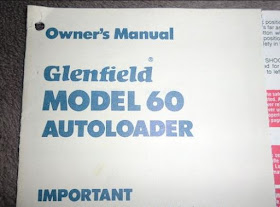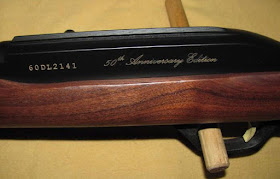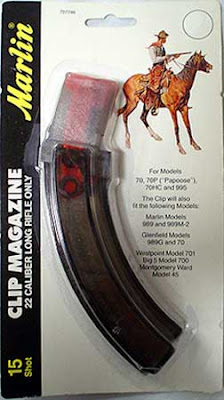For the last couple of years I have been dedicating the month of March to the Ruger 10/22. I decided that I needed to show some love to the venerable Marlin Model 60. So this month I will post modifications you can do to your model 60, some model 60 gun porn, finally I will revisit my Project Night Prowler.
The Marlin model 60 was introduced before the 10/22 and has continued to outsell the 10/22 (although that is slowly changing). More than 12 million model 60s have been sold since its introduction in 1960.
If you are completely unfamiliar with the model 60, it is a self-loading .22 rifle, using blow back operation.The cartridges are loaded into a tubular magazine below the barrel.
Specs:
Caliber: .22 Long Rifle
Weight: 5.5 lbs / 6 lbs
Barrel Length: 19 / 22
Overall Length: 37.5"/40.5"
Length of Pull: 13.5"
Rifling: 1 in 16", RH, 16 Grooves, "Microgroove rifling"
Magazine: Tubular, under barrel
Magazine Capacity: 15 / 18
Material: Cast Aluminum (receiver), Carbon Steel (barrel)
Stock: Birch
Finish: Blued steel (barrel) painted aluminum (receiver) walnut finish birch (stock)
The model 60 started its life in 1959 as the model 99. The model 99 was designed in Marlins original New Haven plant by gun designer Ewald Nichol. It replaced the earlier model 98 (which similar to Winchester's model 74). The idea was to create a less complicated .22 that was cheaper to manufacture.
The Marlin model 99
A year after the introduction of the model 99, some changes were made to create the model 60 including:
- switching to Marlin's Micro-Groove rifling
- adding a cast in scope rail
- switching the stock material from walnut to birch
- replacing the inner magazine tube's steel with brass.
You would think that the gun superseding the models 98 and 99 would be called the model 100....except for the fact that Marlin already had a model 100, being made since the 1936. So Marlin went back to the old way of naming its rifles: by the year of introduction, thus the gun became the model 60. The model 60 designation had also been used before by Marlin, on a single shot, break open shot gun.
The model 60s full name was Marlin - Glenfield model 60. The Glenfield name was originally two words Glen & Field (glen is an old English term for valley). The name Glen & Field was another creation by Ewald Nichols.
Marlin execs changed it to one word and the name was used up until 1983.
Some of the model 60's had a "squirrel stock" like the one below, the stock had a squirrel and pressed in grooves on the wrist and matching grooves on the forend.
Others had an Oak Leaf motif, after 1983 were just plain
For years the model 60 (as with other Marlin models) came with a sticker bearing the signature of the employee who test fired the weapon:
Changes
Originally the rifle had a 22 inch barrel and a full length magazine with 18 round capacity. In the late 1980's the leftists in New Jersey passed a capacity limitation of 15 rounds and rather than risk losing business to one state, Marlin shrunk the magazine capacity to 15. An easier solution would have been a different inner mag tube that limited capacity for the rifles being sold in New Jersey.
This resulted in the barrel being longer than the magazine. Marlin remedied the issue in 1999 by shortening the barrel to 19 inches (IMO they should have went back to the 18 round magazine).
The original feed throat was manufactured from a "pot metal" which wore out prematurely, so in 1976 Marlin redesigned it. The "feed throat" has the feed ramp and an integral ejector molded into it. In the older models, it was molded in two pieces that fit together length wise & were held together with a single rivet. Due to reliability and durability issues, this design was later changed to a single cast piece that uses one tail of the lifter spring as the ejector.
new feed throat (left), old feed throat (right)
In 1980 Marlin changed the bottom contour of the breech bolt and was forced to modify the feed throat to fit. The original breech blocks and feed throats were angled, and are found on rifles made up to 1980. At the time the breech block configuration was changed, the hammer assembly was also redesigned. If any hammer parts need to be replaced, the new-style assembly will have to be ordered.
The original trigger guard configuration had two screws at the rear of the guard, one to hold the guard to the stock and a bolt to hold the stock to the receiver. The original trigger guards were made from cast aluminum. In 1977 the trigger guard material was switched to plastic.
After Marlin decided two screws were unnecessary and more costly, a change of the trigger guard design and stock was made in 1981 to accommodate a single rear guard screw. The newest version is wider than the originals (metal and plastic) and they do not interchange.
Another area which has been revised is the front sight and front magazine-tube hanger. The original version had die-cast loops held in place with a small set screw. The top loop contained an integral front sight. The bottom loop supported and pinned the front of the magazine tube in place. Recoil, however slight, loosened the loops. These would move about, prompting the design to be changed in 1975.
In 1984 Marlin added a last shot bolt hold open feature. This helped prevent dry-firing the rifle after the magazine went empty.
Model 60s that have the last shot hold open and the 18 round magazine are some of the most sought after. These were made between 1984 and sometime around 1987.
A change in the attachment method of the sideplates to the receiver was made in 1980, a few years before the addition of the hold-open. The original method used two front assembly screws, an assembly post, and assembly-post screw for the rear. The latest version has eliminated these parts. The rifle now utilizes a tongue-and-slot method to hold the front of the sideplate assembly in its correct position with the receiver; a split plastic rear-assembly pin retains the back. Needless to say, this version will not work on older guns.
At some point Marlin added a screw to the wrist of the stock, they were having issues with cracking and breaking stocks. The screw fixed the problem.
You can see it in the picture below (top stock), also note the different profile of the trigger guard cutout on the bottom stock
In 2005 Marlin changed the size and shape of the charging handle. The early ones were curved and had a shank width of .4015", the later ones were rounded (like a spool) and had a shank width of .3755".
old charging handle
new charging handle
the Marlin model 70
In 1986 Marlin introduced a take-down version of the model 70 called the model 70P "Papoose". It came with a carry pack and take down wrench
the model 70 Papoose
There was also the model 990, a model 60 variant that was made from 1979 to 1987. Below is the Ducks Unlimited model
A while back Mossberg began marketing a copy of the Marlin model 70/795. Called the 702 Plinkster, it is built by CBC in Brazil and uses a near exact copy of the Marlin action, with a modified trigger group. CBC/Magtech also sell this rifle as the model 7022.
Here is a time line of events:
1959: Ewald Nicols designs the model 99
1960: Model 99 redesigned as the model 60
1964: Ruger introduces their 10/22 rifle for just $0.55 more than the model 60
1965: Model 989M2 introduced
1967: Model 70 introduced
1969: Marlin moves production from New Haven to North Haven (Connecticut)
1975: Front Sight and Magazine Mount changed
1976: Feed Throat redesigned
1980: Bolt, Feed Throat and Action redesigned
1981: Trigger Guard redesigned
1983: Glenfield name dropped, stock embellishment ended
1984: Last Shot Hold Open feature added
1986: Model 70 Papoose introduced
1987/88: Magazine capacity reduced to 15 rounds
1997: Model 795 introduced
1999: Barrel length reduced to 19 inches
2005: Charging Handle redesign
2007: Marlin is acquired by Remington
2010: 50th Anniversary model
2011: The Marlin North Haven plant is closed, manufacturing is moved to Remington in Ilion, New York & Mayfield Kentucky
2016: Mayfield Kentucky plant closes, production of the model 60 is moved to Huntsville, Alabama
For years the model 60 was shipped with the owner's manual as part of the "hang tag" attached to the trigger guard.
You can use the chart below to date your model 60
The rifle was (and still is) extremely popular and was once sold in department stores, hardware stores and auto parts stores across the U.S. and Canada.
You may be the owner of a name branded model 60 and not even know it. Marlin brand labeled the model 60 for several retailers, below is a list of the ones that I am aware of.
Glenfield Model 60
Glenfield Model 65 (Golden 50)
Coast to Coast (United Merchant):
Model 5
Model 40
Model 550
Model 600
Model 608CC
Cotter & Company:
Model 601
Model 60-50
Westpoint GA22
Westpoint 45
Westpoint 601
Montgomery Wards:
Western Field 50
Western Auto Supply:
Revelation model 120
JC Penny:
Foremost 6660
Otasco (Oklahoma Tire & Supply & Big 5 Sporting Goods):
Otasco 65 ("Golden 50)
Big 5 model 5
Otasco 6060
Otasco 6079
Otasco 6080
Otasco 6081
Otasco 6082
Otasco 6083
Otasco 6084
Otasco 6085
Otasco 6086
Otasco 6087
There is no way to cover all of special editions that were commissioned over the years, but we will look at a few of them.
Among the many special editions are a couple of stand outs, one is the "Golden 50" model. Beginning in 1968 Marlin began making this special edition for Oklahoma Tire and Supply Co (OTASCO). They were unique in that the outer magazine tube was made of brass. Supposedly only 44,369 of the Golden 50 models were made.
Later the brass tube was used on other brand labeled guns like the Westpoint model below that was made for Cotter & CO (True Value)
In 2010 the model 60 turned 50 years old and Marlin celebrated with a 50th anniversary model. Based on their Deluxe model (model 60DLX) it featured a checkered walnut stock, a real rubber recoil pad, folding rear sight, hooded front sight and gold filled roll marks. The first 200 of them had 60DLX as the serial number prefix, the following ones used 60DL for the prefix. The reason was because of an error made in production, the serial number engraver can only do 8 digits and it was not noticed until the 200th gun had been engraved.
In addition the first 1000 or so 50th anniversary models were made at the Marlin North Haven plant. The remaining units were made in Remington's Ilion NY plant. This makes the first few 50th Anniversary Models that much more of a collector's item.
Remington continues to produce the model 60 (many call these new ones "Remlins"). For a time production of the venerable rifle was performed in Remington's Mayfield, Kentucky plant.
How ironic is it that the old "Glenfield" was being built in a town called Mayfield?
Now production has been moved once again, this time to Remington's Huntsville, Alabama plant.
I have owned 4 model 60s (currently own two) and one model 70. The model 70 was my first rifle.
I bought my model 70 at Big 5 Sporting Goods on sale for $99, Ram-Line was making the high cap magazines and even brand labeling them for Marlin. I had two of them, a 15 round and 20 round.
Marlin at one time offered a model 70HC, which came with the Marlin branded high capacity magazine(s). The model and the magazines were disco'd in 1994, thanks to the Democrats and their "Assault Weapons Ban".
I traded this gun away, something I now regret.
I bought this scoped model 60 at a gun show for $125, I ended up selling it to buy something else, never even shot it.
I got a stainless model 60 from a local gun forum member for $150, I traded it later for a huge lot of gun parts, worth three times as much.....
Here are my two current model 60s. This first one was a rusty, ugly, unwanted gun I rescued it from a gun show for $50. I turned it into a project, see the post here
This second one I picked up from a dealer, also for $50. He was liquidating an estate, it was one of 5 guns I bought from him. It is one of the "good" versions, it has the last shot hold open, redesigned trigger and feed system and the 22" barrel with full length 18 round magazine, made sometime in the mid '80's.
I plan on turning this one into the "Ultimate Model 60" by performing some upgrades including a walnut stock (if I can find one).
Sources
Wikipedia
MCARBO
Gunblast
Gun Tests
Practical Eschatology
Thoughts from Dillon




































